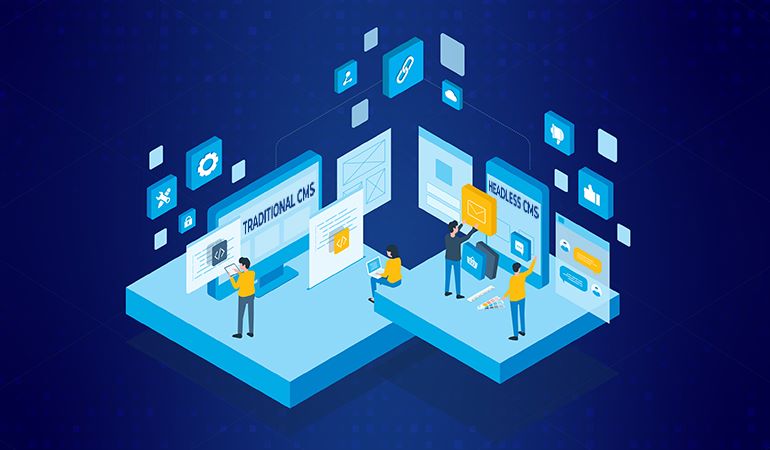Headless CMS vs Traditional CMS: Top Differences in 2025

Content Management Systems have revolutionized through the power of technological enhancements and the need to improve businesses’ digital experiences. Headless CMS vs. Traditional CMS: As of 2025, the debate to attract the attention of most developers, marketers, or enterprise stakeholders is still on fire. Each CMS architecture has its advantages and challenges, making the choice between them critical to the achievement of an organization’s digital goals.
In this article, we examine the pros and cons of headless CMS and traditional CMS so that you can determine which is best for powering your digital experiences now and in the future. We also examine the differences between these popular CMS approaches so that you can select the best CMS development solutions for your needs as a developer, engineer, or marketer.
What is a Traditional CMS?
A traditional CMS is an integrated solution with a closely linked backend (content management) and frontend (content presentation). Some of the popular examples are WordPress, Joomla, and Drupal. They are meant to be easy to use and, therefore, most often used by small—to medium-sized businesses to create and manage websites.
Main Characteristics of Traditional CMS:
- Easy interfaces for non-technical users
- Pre-built themes and templates to get going in no time
- All-in-one content creation, storage, and presentation
- Scant scalability for omnichannel content delivery
However, the tightly coupled nature of traditional CMS can be a limitation to customization when businesses want to deliver content across diverse platforms or want to adopt modern front-end technologies like React or Angular.
What is a Headless CMS?
A headless CMS separates back-end content management from the front-end, where it is rendered, and allows for the use of APIs to deliver the content so that it works seamlessly across frontend development frameworks, devices, or platforms.
Main Features of Headless CMS:
- Delivery of content via APIs
- Free to integrate with modern technologies
- Omnichannel delivery of content
- Scalable and flexible for enterprise requirements
In 2025, the main leading enterprise headless CMS top players include Contentful, Strapi, and Sanity, with more advanced features offered for modern digital product development as well as website branding strategy.
Most Common Differences Between Headless CMS vs Traditional CMS

-
Flexibility in Content Presentation
Traditional CMS: The content is bound to the defined templates. Thus, it becomes difficult to change according to the platforms.
Headless CMS: APIs are used to serve the content, and thus, multi-platform compatibility is achieved, including on websites, mobile applications, and IoT devices. Thus, enterprises often depend upon headless CMS integration in order to achieve this much flexibility.
-
Development and Customization
Traditional CMS: Provides drag-and-drop editors and offers very limited customizability. This is a user-friendly approach for individuals who do not have much technical know-how.
Headless CMS: It provides unprecedented freedom to developers, using frameworks such as React and Angular with front-end development services. It is highly tailored for users.
-
Scalability and Performance
Traditional CMS: Struggles with scalability, especially when traffic grows, necessitating extra investments in IT infrastructure management services.
Headless CMS: Decoupled architecture provides faster performance and scalability, which makes it ideal for enterprises that have complex digital ecosystems.
-
Omnichannel Content Delivery
Traditional CMS: Primarily built for websites, and it needs extra work to be multi-channel delivery.
Headless CMS: This is perfect for a multichannel distribution where the same organization can distribute its content simultaneously in several sites. This feature matches best with organizations providing the service of responsive web design as well as internet presence across continents.
-
Ease of Use
Traditional CMS: Easy to use with intuitive interfaces. It can be used with non-technical users with ease.
Headless CMS: Requires technical expertise so that headless CMS development services are required for smooth implementation.
-
Security
Traditional CMS: More vulnerable since direct backend/frontend coupling introduces vulnerabilities.
Headless CMS: More secure because content delivery happens through APIs, and hence, the exposure of vulnerabilities is reduced.
Why Enterprises Prefer Headless CMS in 2025
-
Future-Proofing Digital Strategies
Companies that use headless CMS are easily adaptable to new technologies like AR, VR, and IoT. This adaptability will ensure that they are relevant and scalable in the long run in this ever-changing digital landscape.
-
Improved Development Capabilities
Headless CMS is an opportunity that directly aligns with React Native development services and Angular development services because it gives developers a chance to create complex, interactive user experiences on the go. The frameworks allow for content to be displayed on any device or platform with minimal restrictions applied.
-
Consistent Branding
With brand audit services and headless CMS integration, businesses can maintain consistency in their branding throughout the digital touchpoints, which will help them reinforce their market presence and credibility.
-
Simplified Infrastructure Management
Most modern enterprises use cloud infrastructure management and IT infrastructure management services to address the complicated digital operations of an organization. Headless CMS manages content centrally while providing it for distribution across different platforms without hassle.
-
Enhanced Speed
Decoupling architectures eliminates the bottlenecks most often associated with traditional CMS systems, which translates to faster load times and smoother user experiences, especially for global users.
Top Headless CMS Platforms in 2025
The best headless CMS platforms market is growing rapidly, with numerous options that cater to a wide range of business needs:
- Contentful: Best for enterprises due to smooth scalability and robust API integrations.
- Strapi: Open source and highly customizable, making it ideal for developers who look for flexibility.
- Sanity: Known for real-time collaboration and intuitive content editing.
- Kentico: Kentico CMS is suited for enterprise-grade content management with advanced features.
- Ghost: Very light and simple, perfect for content-rich businesses.
Traditional CMS: Still Useful
Even though headless CMS development services have become the new hot favourite for enterprises, traditional CMS platforms are still well-suited for certain use cases:
- Small Businesses: The traditional CMS platforms are cheap and easy to use for companies that do not have large development teams.
- Content-Driven Websites: Blogs and simple websites that do not require omnichannel delivery are suitable for traditional CMS platforms.
The Future of CMS Development Services
With the increased complexity of digital ecosystems, CMS development services will evolve more. In 2025, the business solutions will emphasize infrastructural management services, improved responsive web design services, and compatibility with modern technologies.
This also means that in headless CMS vs traditional CMS, the goals are still about engaging, scalable, and efficient digital experiences. What would help businesses achieve those is, after all, the right CMS solution and the right development partner.
Conclusion
The debate about headless CMS vs traditional CMS is more relevant than ever in 2025. Whereas a traditional CMS platform seems quite simple and easy to operate, headless CMS offers unmatched flexibility, scalability, and omnichannel capabilities. Headless CMS development services are one of the cornerstones of digital strategy for all enterprise-focused companies engaged in the process of enterprise web development.
It helps the business improve its web presence by making infrastructure management services easier. The right CMS solution makes it possible to provide better digital experiences for customers. Matters such as responsive web design, brand building, and developing a sophisticated framework definitely come under consideration when a company decides to have the correct CMS.
If you need further help, you can contact us at [email protected] . We will schedule a free consultation session to explore how Xavor can assist you in this matter.
https://www.xavor.com/wp-content/uploads/2024/12/headless-cms-vs-traditional-cms.jpg
2024-12-31 05:52:46




